Last minute information for #sha2014: language, museums, ice hockey …
We have had a few questions concerning language in Québec. Yes, French is the language spoken in Québec City! However, you will have no difficulty being served or getting directions in English! Do try using your French, it’s always appreciated. Have a look at this Youtube clip to see the differences between French as spoken in France and that spoken here in Québec: http://www.youtube.com/watch?v=dw5Re7k1KBA.
There will be simultaneous translation for the Wednesday evening opening ceremonies and plenary session (http://www.sha2014.com/events.html#content6). What does this mean for you? You will be able to pick up a headset at the entrance to the room by leaving an identity card that will be returned to you when you give the headset back. Remember that the opening ceremony begins at 6:00 PM in the Québec Convention Centre, so please show up a few minutes early to avoid the crowd.
Want to visit museums while in town? The national museum “Les Musées de la civilisation” has a special offer for conference attendees. Show your conference name badge at any of the three satellites of the museum and get a substantial reduction on the entrance fee. Full information is printed on the back of your conference name badge. You will be able to visit the “Musée de la place Royale” and see the incredible archaeological collections from this site. The “Musée de l’Amérique francophone” is currently hosting “La colonie retrouvée”, an exhibition about the 1534-1536 Cartier-Roberval site. The “Musée de la civilisation” has several permanent and visiting world-caliber exhibitions. Learn more about the fantastic exhibitions on the “Musées” web page: http://www.mcq.org/index_en.html.
Would you like to participate in a friendly US/Canada hockey tournament? It will be on Saturday evening, January 11, from 5:00 PM to 6:30 PM at the Parc de l’Esplanade outdoor rink on the rue D’Auteuil in the Old Town, just across from the “Assemblée nationale” (Parliament Buildings), but inside the fortification walls. Contact Antoine Loyer Rousselle for more information (antoine.loyer-rousselle.1@ulaval.ca).
The organizing committee is eagerly waiting for you. Have a safe and comfortable trip to Québec City!
What the Tech…?!
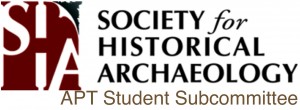 A recent SHA Academic and Professional Training Student Sub-committee survey asked student members what technologies are necessary in archaeology and as professionals. In continuing support of the identification, discussion, and application of relevant technologies, student member, Tim Goddard, agreed to (re)introduce the concept behind the Technology Room – a great space for students and professionals to engage in one-on-one conversations about current technologies in historical archaeology.
A recent SHA Academic and Professional Training Student Sub-committee survey asked student members what technologies are necessary in archaeology and as professionals. In continuing support of the identification, discussion, and application of relevant technologies, student member, Tim Goddard, agreed to (re)introduce the concept behind the Technology Room – a great space for students and professionals to engage in one-on-one conversations about current technologies in historical archaeology.
Thank you for the opportunity to blog about the Technology room from/for a student’s perspective. I gladly serve on the SHA’s Technology committee. I am also a Graduate student finalizing my PhD. Several years ago, when I first joined the committee, one of my first conversations with fellow members explored the challenges of presenting the use of technology to SHA members who were not already a part of the “technology crowd”. For many previous years, the same group of colleagues presented the latest technologies they were playing with and composed the small number of technology sessions at annual meetings. Despite the fun of this, rarely did we see new faces – especially people wanting to learn about technology.
The Technology Committee was created to serve the SHA’s needs as they relate to technology. This can include almost anything, which has been the case thus far. Only the Website has remained outside the purview of the technology committee. We serve to advise the SHA board and any interested members on almost any technology-related application, either for the Society, or for use in the field of archaeology. As you can imagine, this is an extensive scope. The diverse technical needs of archaeologists require that the committee have a number of members from a wide variety of technological backgrounds. We cover topics including: social media, geophysics, remote sensing, data collection, data management, GIS, LIDAR, 3D, virtual worlds, network management, etc.
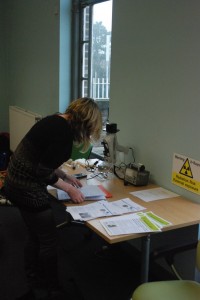
pXRF Technology Leicester 2013. PxRF technology allows us to identify the chemical composition of soils and/or artifacts. The committee regularly offers workshops at the SHA to learn how to use this technology. The following link is an example of one use by one of our committee members David Morgan (http://ncptt.nps.gov/blog/pxrf-presentation-at-lasmaa/).
With some of my own work in WebGIS, I was frustrated that it was not possible to demonstrate my research in a virtual poster session allowing people to view and interact with my presentation via a computer terminal. To do so would have meant me renting a table space, electricity and Wi-Fi, in the exhibition room. Something that is not really feasible for most students! I also know firsthand from teaching that there are a large number of archaeologists that have technology phobias. This fear can be found in young students as well as established emeritus colleagues around the world. So I wanted to know how we could better serve those members at the conferences. We developed the idea of the Technology Room.
Our first experiment with a dedicated technology demonstration space was at the 2011 meeting in Austin, Texas. We decided to focus on three to four key technologies that we felt every archaeologist should know about. We found a handful of our colleagues working with these technologies and invited them to bring the actual technology to our room and to sit down for a block of time to answer questions and provide demonstrations, and hands on experience were possible, for interested colleagues. We strove to recruit archaeologists using technologies in their research projects rather than sales representatives. The idea was great and we got positive feedback, but our execution that first year needed some help.
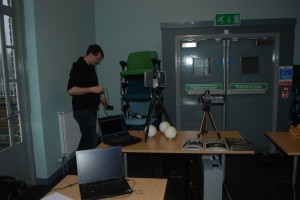
LIDAR technology Leicester 2013. LIDAR typically comes in aerial or terrestrial applications. This is a terrestrial style scanner being demonstrated in the Technology Room. A good link to see LIDAR uses in heritage is http://archive.cyark.org/?gclid=CPX7m8a13boCFQLl7AodR0oAXw.
In the following years we continued to showcase various technologies by having practicing archaeologists demonstrate the technology in the exhibition room, which was always problematic and also made communicating difficult with all the noise. Last year, in Leicester, was the first year that we had our own dedicated room, making communicating much easier. We saw a drop in traffic indicating that we still need to get the word out there about the Technology Room. An undergraduate student who I supported at Leicester found the Room worth noting in a blog he posted about his first conference experience. There is something for everyone in the Technology Room.
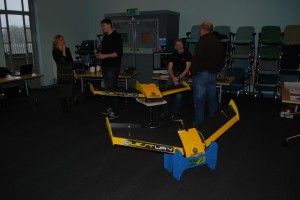
UAV Technology Leicester 2013. Unmanned Aerial Vehicles are popping up everywhere in archaeology. From a simpler Quadcopter to multiple thousand dollar units with multiple sensor platforms are finding many uses every year in archaeology.
What are the purposes of the Technology Room?
- Present the latest and greatest technologies being used in archaeology.
- Have a practicing archaeologist familiar with the technology to educate others about what did and didn’t work.
- Learn what pitfalls to avoid.
- The real costs involved.
- Share technology driven research that can’t always be demonstrated in a traditional symposium.
- Network with various technology minded colleagues
What is the benefit to Students? Students:
- learn about technologies that you might not know about through your own institution;
- are often our best presenters as they grew up in a technology age and can help others with technology phobias in a professional context;
- can learn and see technology in a low pressure environment;
- and can network to find projects using a technology they might be interested in working with.
So I challenge you:
What Technology are you interested in? What role do you feel technology should play in archaeology? What are the problems we face with technology? How can we (SHA) or your institution better train you for technology-related applications?
Comment below as well as stop by the Technology Room this January.
Tim Goddard
#SHA 2014: Social Media at the SHA Conference
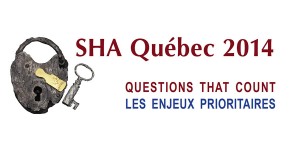 Over the past few years, SHA has built an online presence through the use of social media, and it began within the conference committee. This year, with the addition of the blog, and the society’s developing use of Twitter and Facebook, we want to encourage you all to incorporate social media into your conference experience in Québec City. You can find further information about the use of social media at conferences in general here and here. Using social media during the SHA Québec 2014 meetings will be a snap as high speed WiFi is available free of charge throughout the Québec Convention Centre!
Over the past few years, SHA has built an online presence through the use of social media, and it began within the conference committee. This year, with the addition of the blog, and the society’s developing use of Twitter and Facebook, we want to encourage you all to incorporate social media into your conference experience in Québec City. You can find further information about the use of social media at conferences in general here and here. Using social media during the SHA Québec 2014 meetings will be a snap as high speed WiFi is available free of charge throughout the Québec Convention Centre!
Before the Conference
Using social media before the conference provides a number of opportunities to make your experience in Québec more enjoyable. Here’s some suggestions:
1. Catch Up with What’s Happening: We have a Facebook Page, a Twitter Account, and official Twitter Hashtag. We’ve also been posting blogs about Québec City and the conference since January. Follow and Like Us, and read up on what to expect at the conference!
2. Start Communicating: Twitter is a great way to meet other archaeologists. See who is tweeting with the #SHA2014 tag, and start conversations with them!
3. Advertise your session by blogging and posting: Do you have a blog? Use it to share your session, the reasons why it is important, where and what time it’s being held. Post it on our Facebook wall and send a tweet with #SHA2014 and @SHA_org mentioned, and we’ll share it with our members!
4. Share Your Trip: Let us know what’s happening on your trip to Québec City. Did you find a good travel deal? Need someone to share a ride with from the airport? Delayed? Lost? Send a tweet with the #SHA2014 tag and see if someone can lend a hand.
At the Conference
Once you arrive in Québec City, use @SHA_org and our Facebook page to communicate with the conference committee; we’ll be using it to communicate with you. Here are some things we’ll be using social media for:
What we’ll be doing
1. Announcing special events: We’ll send out reminders about events including the awards banquet, student reception and so on, so you don’t miss anything.
2. Special Announcements: If something is relocated, delayed, or cancelled, we will announce this via social media.
3. Answering Questions: Send your questions to @SHA_org or the Facebook page.
4. RTing and RePosting: We’ll repost on Facebook and ReTweet on Twitter the things you share on the #SHA2014 hashtag. If you’ve taken a great picture, made an interesting comment in a session, or provided some good information, we want to make sure our followers see it!
What you can do
1. Post YOUR Special Announcements: Has something happened in your session that is delaying things? Have you found a great restaurant or coffee shop you want to share? Spotted your book in the book room? Post these items and we’ll repost them so others can see them.
2. Ask Questions: Use Twitter and Facebook to ask questions about the conference. Can’t find a room? Can’t remember what time the Awards Banquet is? Send a tweet to @SHA_org or post on the Facebook wall and we’ll get back to you.
3. Take Pictures: we’d love to see and share your pictures from the conference, particularly from the special events. Conference photos will be posted on the SHA Facebook wall. If you post them on Twitter, please use the #SHA2014 tag!
In a Session
Twitter can be particularly useful when you’re in a session. It provides a backchannel of commentary and discussion, so people who couldn’t attend the session or conference can still follow along. It also gives presenters and chairs a chance to get some feedback on their presentation, and to communicate with the audience – leading to interactions and relationships that might not have occurred otherwise. Here are some tips to maximize the effectiveness, and civility, of Twitter. You can find more hints and tips here.
For Session organizers
1. Use a Hashtag: It’s OK with us if you give your session its own hashtag; this way, it is clear what tweets belong to what section. We STRONGLY advise that you also use the #SHA2014 hashtag, so that people following it will see your session as well. Otherwise, it may not be noticed. So, pick something short to save characters!
2. Make it Known: Make sure all your presenters know about the hashtag, and that you’d like to use social media during the session. Make sure that the audience knows as well; tell them as you introduce the session. Also, encourage your presenters to include their own Twitter name and the session hashtag on their introduction slide, so that people can use it during their presentation.
For Presenters
1. Be Loud: include your Twitter name on your presentation slides, and say something in your introduction about how you’d like to hear feedback on Twitter. If you DON’T want anyone to broadcast your session, make the request at the beginning of your presentation.
2. Respond: Be sure to respond to the comments that you get, and build relationships!
3. Pay it Forward: Be an active tweeter during the session for your fellow presenters.
For the audience
1. Be Respectful: Don’t tweet anything you wouldn’t say to a presenter’s face; Twitter is, in general, a friendly place. Constructive criticism is certainly welcome, but remember you only have 140 characters. It’s probably best to send the presenter a private message saying you’d love to chat about their presentation rather than publicly dig into them. If a presenter requests silence on social media for their presentation, respect it and give your thumbs a rest.
2. Introduce your Speaker: It’s courteous to send a tweet out introducing the presenter and their paper topic before starting to tweet their presentation: this gives those following some context.
3. Cite: Use the presenter’s Twitter name, surname, or initials in all the following tweets so that their ideas are connected to them. Use quotes if you’re directly quoting someone from their presentation, and be sure to include their name. Remember: these presentations are still the presenter’s intellectual property, so treat it respectfully!
After the Conference
Just because a conference is over, it doesn’t mean the work is done! The same goes for social media; here’s how you can round out your conference experience:
1. Write a Summary: Use a blog or Storify to give other archaeologists a glimpse into your experience, session or paper, and see what they missed. This also allows us to gather feedback about the conference so we can make it better next year! Be sure to post it on Twitter, use the #SHA2014 tag, and post on our Facebook page so others can see it!
2. Post your Paper: Using a blog or academia.edu to post your paper is a great way to make it available to everyone. Or you could make a video; simply record yourself talking over your slides and upload it to YouTube or Vimeo (read more about this here). Then, share it with us!
3. Build your Networks: Build longer lasting relationships by looking up the people you’ve met at the conference on Twitter, Facebook, and LinkedIn (oh, we have a LinkedIn Group, too, just for SHA members). If you find them, send them a message saying how nice it was to see them!
It Takes a Village to Build a Trail
by Jennifer McKinnon
When I think back on the experience of building a maritime heritage trail, probably much like others who have worked on public or community projects, I get nostalgic about all of the friends and colleagues I met during the process. The old adage about it taking a village to raise a child also rings true for community projects such as heritage trails – it really does “take a village to build a trail.”
Community projects by their very nature are incredibly complicated, but can be infinitely rewarding. In a community as diverse as the Commonwealth of the Northern Mariana Islands (CNMI), any project leader must understand that there are multiple voices to be heard and incorporated. This can be learned the hard way or the hard way. What I mean by the hard way is that no amount of research can prepare one for the diversity in meaning and importance of heritage to a community; one member has a completely different understanding of a shared bit of heritage from the next member. And it is important to incorporate as many of those voices as possible.
This is the task that I set about doing six years ago when I stood in front of a crowd in a smoky little restaurant that consisted of both divers (there to see my presentation on heritage trails) and an angry group of fishers (there to see a second presentation about a national monument which was set to restrict their access to fishing and thus their livelihood). What I found that night was a community so passionate about their right/heritage of fishing and opposed to more official colonial platitudes and restrictions. What I learned that night was two things: first, that no matter how well-funded, presented or shiny an idea is, if a community isn’t behind it, it has no worth; and second, the CNMI community was one with a long history of struggling with outsiders and outside ideas, and if progress was to be made, the idea should be locally generated. To this day these two lessons have held true to form and earned friendships and collegial relationships that will last a lifetime, not to mention some great research projects.
The idea for developing a heritage trail was conceived by staff at the Historic Preservation Office (HPO) and shared with me when I first visited the island in 2007. Though originally aiming to build a Spanish colonial research agenda, I was quickly taken by the incredibly diverse and intact heritage related to the WWII Battle of Saipan. With a little friendly persuasion from the HPO, I found myself in conversations about mapping, preserving and interpreting submerged WWII sites which included planes, tanks, shipwrecks and assault vehicles of both Japanese and US forces. The idea to apply for a National Park Service Battlefield Protection Grant launched a one year grant awarded to Ships of Exploration and Discovery Research, which eventually turned into a four year project (and has now moved inland). After holding several public meetings and discussing the trail with various stakeholders (dive shops, boat operators, government agencies, humanities groups, visitor’s authority, etc.) the trail began to take shape. Sites were chosen based on stakeholder and public interest, the history and archaeology was researched with an inclusive approach (including Chamorro, Carolinian, US, Japanese, and Korean groups) and products were carefully researched so as to reach the widest audience possible (all ages and divers and non-divers alike). In addition, since a focus on sustainability was key, the project included both heritage awareness trainings for end users and a conservation survey and management plan (funded by a second Battlefield Grant) that collected baseline data for the HPO.
The interpretive products that make up the trail include nine waterproof dive guides and four double-sided posters in both English and Japanese; a 2D and 3D interpretive film for the National Parks on Guam and Saipan (produced in conjunction with Woods Hole Oceanographic Institution Advanced Imaging and Visualization Lab, National Park Service’s Submerged Resources Center, and Windward Media); and a website which includes information about the Battle and submerged heritage sites.
But let me come back to the idea of it taking a village…the entire project from concept to completion would not have been possible if it were not for the interest of the local community. At every step of the way agencies and volunteers were not just included, but critical to the work. HPO conceived of the idea and several staff members assisted with recording the sites and conducting historical research; they also participated in training, first as trainees (Underwater Archaeology Training) and then trainers (Heritage Awareness Diving Seminar). Coastal Resources Management (CRM) provided in-kind support through the use of boats, fuel and the assistance of staff (i.e. captains, enforcement officers and biologists), as well as participating in and providing instruction during the training sessions. In fact, one CRM employee was so devoted to the project, he took vacation days so that he could participate in the field work! CRM also initiated a program to place moorings on the trail sites in order to minimize impact by visitors. Department of Environmental Quality (DEQ) provided in-kind support by offering boats, captains and expertise. CNMI Council for the Humanities promoted the project to the public by sponsoring public lectures and radio programs. NPS American Memorial Park hosted events such as public lectures, trainings and film viewings. Marianas Visitors Authority provided useful visitor and diving statistics in the planning process. In addition to the government agencies, private individuals hosted barbeques, provided in-kind support for hiring vessels, volunteered to conduct field work and historical research, provided translation services, gave local tours, set up interviews with family members, lent vehicles, and generally treated us as family.
From 2007 to the present I’ve had the privilege (and I do mean privilege) of working with the community/village of Saipan to record and research their maritime history from their colonization of the island some 3500 years ago to the more recent and tragic conflict of WWII. But I suspect there will be many, many years to come because like a snowball rolling down hill, interest builds momentum and once a village gets excited, who knows what may come of it…
So what are your experiences with creating trails or working with a village (community)? In what ways was the success of your project the immediate result of community input and assistance? Do you think the rewards of working with a community outweigh the complexity of the process?
#sha2014, Getting Ready for Quebec: Advice for Session Chairs

Here is the link to the conference website where you can find the final program: http://www.conferium.com/OLM/Prg_Present.lasso?showevent=361
Thank you again for organizing and chairing a session at the 2014 SHA meetings. As the conference draws near, we ask you to assist with final preparations.
Before your session starts:
— Know the a.v. requirements of your presenters. PowerPoint projectors and laptops are provided for all sessions. Please coordinate with session presenters to ensure that their presentations are loaded and working. SHA volunteers can help you with this if needed.
— All presenters should bring a flash drive containing the relevant file so that it can be uploaded to the computer before the session begins. Session chairs should check for compatibility issues between pc and mac versions of PowerPoint and for compatibility issues before the session begins.
During your session:
— Begin papers on time as scheduled in the program, remember they are 15 minute papers! If an author does not show up, wait for the next scheduled paper and encourage discussion. Please do not change the order of presentation or the scheduled start times for papers. Be prepared to facilitate the discussion period if there is a 15 min. break in your session.
— Have a watch or clock—Use it! Let your presenters know when they have 3 minutes, or that time is up. As time runs out, diplomatically inform the speaker that his or her time has expired, and request that the speaker conclude the presentation. Volunteers will provide you with prepared cue cards for 3 minutes and PLEASE CONCLUDE!
If you have any questions at all, please let us know ahead of time and we will provide what assistance we can. Thanks for working with us to make the meetings a success! Good luck with your session and we look forward to seeing you in Quebec City.
Programme Committee
SHA 2014
At a Glance: Student-focused Activities at the SHA 2014 Conference
 SHA student members will participate actively in this year’s annual conference. In addition to the familiar, the APTC Student Subcommittee (SSC) is hosting new events. Students in Quebec City will find focused events occurring every day of the conference. Here is a brief guide and links for more details.
SHA student members will participate actively in this year’s annual conference. In addition to the familiar, the APTC Student Subcommittee (SSC) is hosting new events. Students in Quebec City will find focused events occurring every day of the conference. Here is a brief guide and links for more details.
A SHA tradition, the Past Presidents’ Student Reception will be held this year on January 9th starting at 4:30. The SHA likes to support its students and this is how the past presidents’ show it. Senior members of the organization, including SHA past and current Presidents, join in the mix. This mixer is an opportunity to chat with them as well as to meet other students.
Earlier on January 9th the SSC will host, in collaboration with the SHA’s Ethics Committee, its first ever Ethics Bowl. Come support competing teams engaged in ethical debates of import to all practicing archaeologists. If you missed out on this year’s competition don’t worry the SSC will be signing up teams for next year.
Don’t know what a Pecha Kucha is? Join us on Friday for this fast paced fun new session format. Suggested by our new friends from University of Laval, each presentation will show twenty slides for twenty seconds and be followed by a brief discussion.
Next up is the SSC RAP Session. This informal session encourages dialogue directed by students. Panelists join students in small groups or talk one-on-one about career goals, research issues or simply negotiating coarse work. Pop in and meet some SHA members who have made themselves available directly to students for this unique session.
The Conference Committee has been incredibly generous to the SSC this year. Most committee meetings take place very, very, very, early in the morning. This year, however, the SSC meeting has the most favorable slot- lunchtime on January 11th. So grab a sandwich and come join the Student Subcommittee. It is the best way to make new connections, participate in the SHA and gain leadership experience.
Traditionally the SSC and ACUA co-sponsor a special forum for students. This year’s topic, “Reaching Out: Public Archaeology for Students and New Graduates,” will address issues ranging from the practical to the ethical. This dynamic group of panelists should not be missed.
If you’re in the bookroom, stop by and say hello! SSC members will periodically be available at the SHA table. If we’re not there, please snag a flyer, which includes information about how you can participate in the SHA’s only student-run committee.
Finally, if you want to contribute to discussion or follow student-related goings on at SHA, you can search and follow social media tagged with #SHA2014, #SSC, and/or #students.
Here is a quick summary of sessions. Double check event rooms as they may change.
Schedule at a glance:
Jan 9
PAN3-8 Ethics Bowl 301B 1:30-3
Jan 10
PAN-92 Powered by Pecha Kucha Session 207 1:30-3
PAN-106 RAP session 207 3:30-5
Student Awards 200C 5-6
Jan 11
MTG-24 Student Subcommittee Meeting See Prog. 12-1:30 ALL WELCOME
PAN-149 Forum 207 1:30-5
Panel Session Topic: “Training Historical Archaeologists in the 21st Century: Does Theory Matter Anymore?”
 Terry Majewski and I are facilitating what will undoubtedly be a thought-provoking, highly interactive, and potentially controversial panel discussion on the training of historical archaeologists. The session, entitled “Training Historical Archaeologists in the 21st Century: Does Theory Matter Anymore?” will be held on Thursday, January 9, from 1:30 P.M. to 5:00 P.M. (Room 301A). Panel members will include Mary Beaudry, Lu Ann De Cunzo, John Doershuk, Adrian Praetzellis, Timothy Scarlett, Teresa Singleton, and Mark Warner. This session will include lots of time for questions and discussions among the panel members and session audience, so we hope many of you will be able to attend the session.
Terry Majewski and I are facilitating what will undoubtedly be a thought-provoking, highly interactive, and potentially controversial panel discussion on the training of historical archaeologists. The session, entitled “Training Historical Archaeologists in the 21st Century: Does Theory Matter Anymore?” will be held on Thursday, January 9, from 1:30 P.M. to 5:00 P.M. (Room 301A). Panel members will include Mary Beaudry, Lu Ann De Cunzo, John Doershuk, Adrian Praetzellis, Timothy Scarlett, Teresa Singleton, and Mark Warner. This session will include lots of time for questions and discussions among the panel members and session audience, so we hope many of you will be able to attend the session.
The panel discussion begins with the premise that historical archaeology still falls within two overarching theoretical camps: (1) postmodern/post-processual archaeology and (2) processual archaeology. The former includes multiple approaches such as critical theory, Marxist theory, feminist or gendered archaeology, post-colonial archaeology, practice theory, etc. Processual archaeology is a continuation of the New Archaeology of the 1970s, which applies scientific methods to archaeological research. Our panel of prominent historical archaeologists will evaluate the role and impact of these differing theoretical orientations in preparing students for careers in both academia and the world of cultural resource management (CRM)/heritage management. Our panel members, representing both academia and applied archaeology, including CRM, will be asked to consider whether or not these two differing theoretical orientations have equal applicability toward advancing a student’s career in academia vs. a career in CRM; and toward contributing to the questions that count in historical archaeology.
The panel will be asked to address the following questions:
Question 1: The majority of historical archaeology in the United States and Canada is conducted to fulfill the requirements of environmental and historic preservation laws. How can training in a postmodern approach to historical archaeology benefit a student seeking a career in CRM, when the work they will be doing:
- will be conducted in a business or government agency context,
- will involve the production of technical reports to be reviewed by government agencies,
- will be used to demonstrate legal compliance with historic preservation and environmental laws, and
- might also involve the implementation of public outreach and engagement programs, and consultation with descendent communities and other public stakeholders in the archaeological effort?
Question 2: The articles published in Historical Archaeology and recent volumes on the discipline of historical archaeology seem to suggest that postmodernism is the predominant theoretical orientation for historical archaeological endeavors in academic settings. This also seems to be the case in terms of the sessions and papers presented at SHA’s annual meetings over the last several years. Do you believe that this is the case, and if so, what role, if any, does a processual approach to historical archaeology have in the training of university students for a career in academia?
Question 3: Do we have an ethical obligation to objectively present the realities of the job market to students pursuing a career in historical archaeology? If we do, what are the most effective methods and approaches to present these realities to students?
Question 4: How can we ensure as a discipline that practitioners in all career tracks have the opportunity, grounding, and commitment to make a difference and contribute to answering the questions that count in historical archaeology?
Hope to see you at the session and we look forward to some lively discussions!
18th Annual Archaeological Photo Contest in Quebec
There is still time to enter!
The ACUA invites SHA members and conference attendees to participate in the 18th annual Archaeological Photo Festival Competition. You can submit entries by sending or by bringing them to the conference in Quebec. Entries must be mailed by December 15 to insure delivery. For all the details, download the 2014 Instructions & Application from the ACUA website (www.acuaonline.org) or the SHA conference website (www.sha2014.com/events.html).
Whether you plan to bring or courier your entry, please email the form to Charles at: Charles.Dagneau@pc.gc.ca or fax it to him at: 613-993-9796. All entries will be displayed during the SHA conference on Historical and Underwater Archaeology and will be posted to the ACUA website. Selected entries will be included in the 2015 ACUA Photo Contest calendar. Just think, your photograph could be featured on the cover! You too can enjoy the adulation of your friends and colleagues, but only if you enter.
Some of our colleagues’ images are featured in the brand new 2014 Photo Contest Calendar! It has fantastic photos by: Drew Buchner, Brett Seymour, Thierry Boyer, Robert Church, Sue Reichert, Erica D’Elia and Dan Warren.
Fall 2013 SHA Newsletter
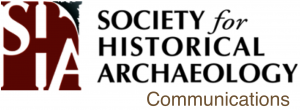 The Fall 2013 SHA Newsletter is now on its way to members. Of particular note in the current issue is a story from Charles Hodges regarding a recent metal detecting event at the iconic site of Flowerdew Hundred, a site which is important not just for its archaeological record, but also for its important role in the development of North American historical archaeology. In March 2013, Flowerdew Hundred was the site of the “Grand National Relic Shootout”, a largescale metal detecting event undertaken without any archaeological involvement, and allegedly without the informed consent of the landowner. This cautionary tale will be of interest to any SHA member interested in the ongoing debate about the interaction between archaeologists and different metal detecting groups. The story is being presented to SHA members in coordination with the Council for Northeastern Historical Archaeology, and will also be printed in the Fall CNEHA Newsletter. Other highlights in the Fall issue include a story from Eleanor Breen and Esther White offering a case study of surveying archaeological repositories in Virginia, and the print version of the 2014 SHA conference preliminary program – here’s hoping we’ll see many of you in Quebec City this January!
The Fall 2013 SHA Newsletter is now on its way to members. Of particular note in the current issue is a story from Charles Hodges regarding a recent metal detecting event at the iconic site of Flowerdew Hundred, a site which is important not just for its archaeological record, but also for its important role in the development of North American historical archaeology. In March 2013, Flowerdew Hundred was the site of the “Grand National Relic Shootout”, a largescale metal detecting event undertaken without any archaeological involvement, and allegedly without the informed consent of the landowner. This cautionary tale will be of interest to any SHA member interested in the ongoing debate about the interaction between archaeologists and different metal detecting groups. The story is being presented to SHA members in coordination with the Council for Northeastern Historical Archaeology, and will also be printed in the Fall CNEHA Newsletter. Other highlights in the Fall issue include a story from Eleanor Breen and Esther White offering a case study of surveying archaeological repositories in Virginia, and the print version of the 2014 SHA conference preliminary program – here’s hoping we’ll see many of you in Quebec City this January!
You can also download the summer 2013 newsletter at sha.org, along with an archive of all our previous versions.




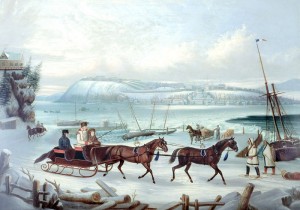
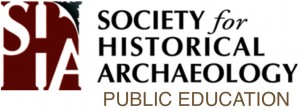
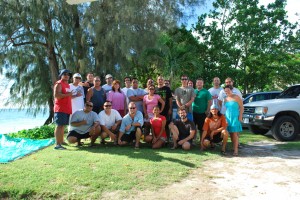
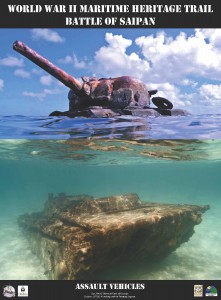
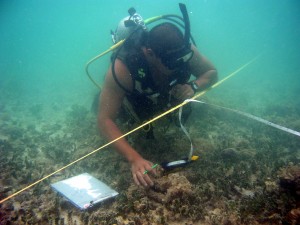

Pingback: WAC May 2012 eNewsletter – Volume 40 – World Archaeology Congress